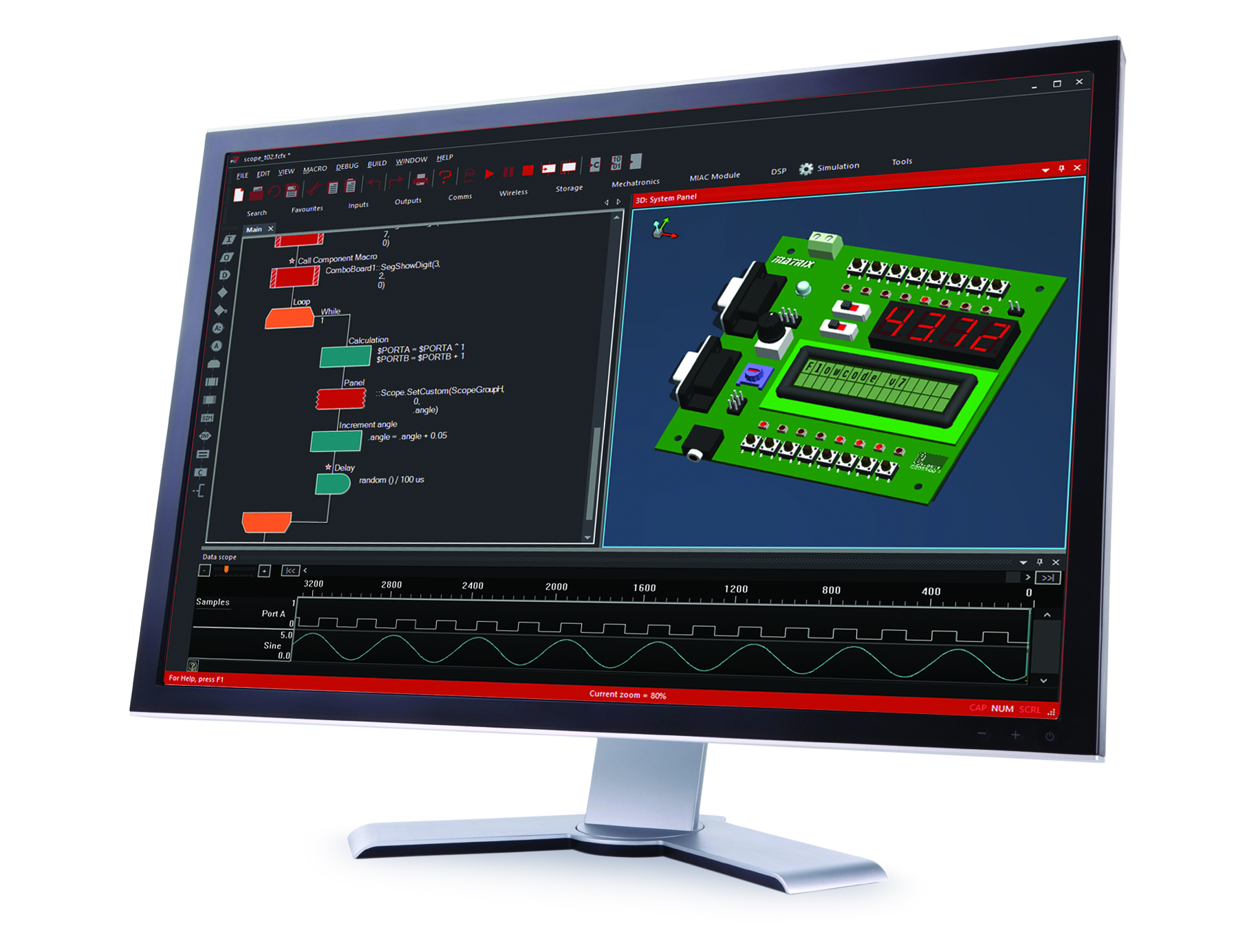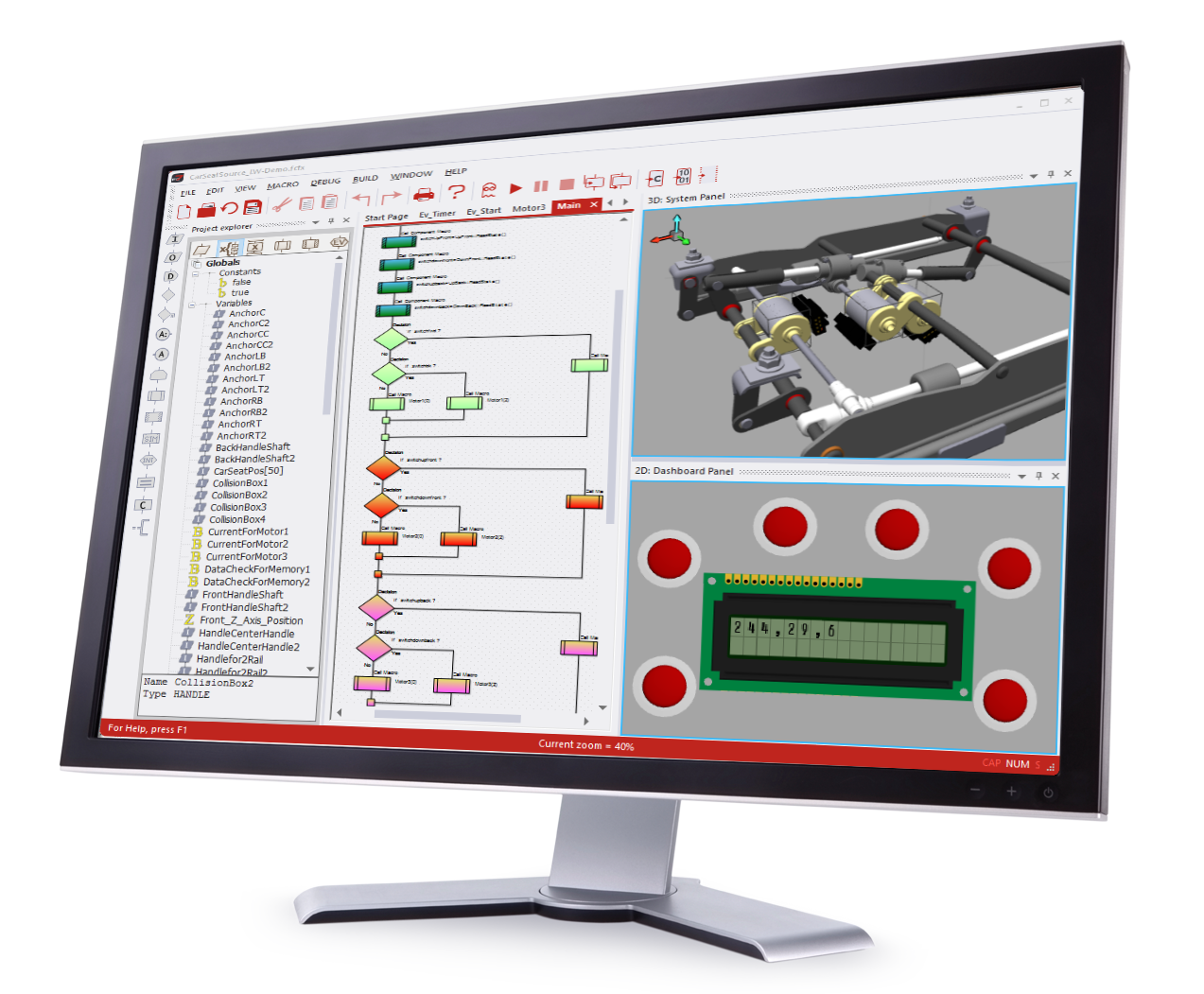Flowcode 7: Do more, use Flowcode
 It’s been almost three years since we launched Flowcode 6, in September 2013. At the time, it was seen as the most advanced, system design software the Matrix development team had ever delivered.
It’s been almost three years since we launched Flowcode 6, in September 2013. At the time, it was seen as the most advanced, system design software the Matrix development team had ever delivered.
Back then, we set out to launch a variety of new and exciting features within the software, which would hopefully assist in the growth of many more users using Flowcode as their tool of choice for programming microcontrollers and electronic systems.
Later this summer, Flowcode 7 will be launched into an ever-changing and rapidly developing market with some really exciting new features.

The journey so far
With well-established routes in education, with Flowcode 6 it was decided that the continuous merger of a variety of strands of engineering including mechanical, test, and electronics would drive a number of the new features we introduced. For example, the trend to study both electronics and mechanics together in education implied that Flowcode should appeal more to mechanical engineers, just as much as it already did to electronic engineers. As a result, we introduced the first 3D system panel and 3D simulation into Flowcode 6 to great effect.
One of our biggest growth markets was the number of electronic and test engineers using Flowcode to test and debug their program designs. With this in mind, we introduced a new technology known as Ghost which provides a real time log of the status of all the pins on the microcontroller whilst a Flowcode program is running on the device on board specific Matrix hardware.
Also with the introduction of Flowcode 6, came an expanded component library to include many new electronic and simulation components. Users could now design their own electronic components and add them to their library.
So, where next?
Since 2013, these trends have continued, but we have seen some major developments in the way microcontrollers are used both by education and professionals around the World.
In the same way we saw 3 years ago, we are now seeing an ever-increasing merger between engineering departments and the requirement of various types of engineers to work with microcontrollers. In education for example, the publishing body Pearson have recently published specifications for their new BTEC qualifications at level 3 (16 to 18 years). Within this, engineers studying mechanical, aviation, manufacturing as well as electrical and electronic engineering must study 120 hours on microcontroller systems. Flowcode has been listed as one of just a handful of acceptable microcontroller programming languages. The reason being, it makes the job of the teachers and students easier – allows them to do more and achieve more!

Being aware of this, we have therefore vastly enhanced the 3D importing of models into Flowcode 7. Using packages such as Solidworks, DesignSpark Mechanical and more, users can quickly and easily develop 3D models and assemblies, then export the files and open them in Flowcode. Following this, characterising the electromechanical elements of the design is straightforward too, by making motors move, actuators and servos work etc.
Debugging and Ghost technology has also been taken to another level. A new and improved oscilloscope will be launched in Flowcode 7 which will include triggering. This will make Ghost technology on Matrix hardware easier and quicker than ever before. We hope this will revolutionise the capabilities of both those who are learning and developing products.
Another feature which will be introduced for Flowcode 7 is code profiling. This features shows when icons have been ‘hit’ during a simulation run, highlighting sections of code that may be deemed redundant and other parts which are executed more often and may need optimising to improve program efficiency.

Faster compilation
One of the bug-bears of Flowcode over the years has been the speed that Flowcode compiles designs to the popular PIC target devices including the 8 and 16bit chips. With Flowcode 7, this will be drastically improved. We have been working with Microchip to ensure that Microchip XC compilers are included in the upcoming version, improving the speed at which PIC devices compile by more than ten times.
More for professional engineers
Since we launched Flowcode 6, the number of professional users has increased rapidly. With thousands of professional engineers now using Flowcode at their place of work and in their homes, it was always important for us to develop a licensing structure that licenced these users fairly and in a way which suits them. With this in mind, we’re introducing a new method of licensing. For educational users, this will remain largely as it always has been, but professional users will now be able to tailor licences specifically to meet their own requirements by adding individual device support, features and further users to their licence at gradually incremental costs.
Furthermore, we’re adding a new and exciting device support with Flowcode 7. For the first time, we will be supporting the PIC32 devices from Microchip – a range of MCU’s which are growing in popularity, particularly amongst engineers looking for a microcontroller with more enhanced processing power, memory and peripherals.
Supporting you all the way
One of the key new offerings in Flowcode 7 will be a welcome increase in help, support and guidance. Whilst we will continue to offer the ever-helpful Matrix forums which are manned by our engineers and experts, we will also introduce offline help files for users. We will also give the Flowcode wiki site an update to reflect our Flowcode 7 developments and also give users access to free online courses on Flowcode, which will give them the ability to make a start with their developments and designs and conduct some test programs and examples. A getting started guide will also give those completely new to Flowcode a head-start on using the environment.
Looking good
Something we pinpointed from the start of Flowcode 7 development, was the need for us to enter the modern era of software development and look towards a new look, feel and user interface for Flowcode. We have canvassed the views of a number of existing Flowcode users. We have also taken into account the way other software delivers an easily-navigable user-friendly experience and come up with a fresh looking user interface that will hopefully give you; more development space, improved graphics, better support for touchscreen devices, simplicity (via beginner and expert modes) and a cleaner C code output. Icons can now be customised in colour too, giving much more control over the look of the programs users create. This can happen globally through the adoption of various “schemes”, or icons can be individually coloured to make important parts of your code stand out.
A free version – no catch!
Whilst Flowcode will still give professional and educational users everything they require from an advanced graphical programming IDE, we also have something new and exciting for those who want to test the power of Flowcode. We’re going to be offering a completely free version of Flowcode 7. The free version will be restricted – in terms of routines and sub-routines users can develop, components available, target devices to which users can compile code and the ability to use the software in a commercial and on a multi-user basis (for education) – but it will give users a fantastic opportunity to get a good feel for what’s possible, whilst creating some useful and interesting projects at the same time.
As you can see, there’s lots to be excited about with Flowcode 7. We’ll be maintaining the same core functionalities of the software, whilst improving the look and feel, the ability to do more with Flowcode for mechanical and test engineers and also improving usability beyond any other previous version.
Over the coming weeks, keep a look out for a number of more detailed articles from us which will put more detail towards the plans for Flowcode 7 and its capabilities.
Flowcode 7 will be available from www.matrixtsl.com this summer. Keep a look out for an official launch date to be announced soon.
29,260 total views, 4 views today




hi guys
read here just in time.
wow!….you have many good futures in it.
I am very excited.
can not wait to work with the version.
let us fidget not so long
best wishes
rudi 😉
I love the new look i hope that it is easy to use. I hope that you can use more of the new features that pic are now fitting into the new pics.
Wow can’t wait for flowcode7. Great Job.
Excellent news that this new version will include PIC32 devices, we have been using Flowcode 6 for many years starting with version 4, and it has helped a lot in code and module design and testing, now with PIC32 we can also use it for our top of the line designs.
Great news!
Really looking forward to! To get the free version that’s good!
Thanks. We need new examples such TV remote control (transmitter and receiver), sinusoidal PWM ,PID control, measuring time between two waveform,etc.
Hi Mohammad. You can find some Flowcode 7 example files that may help you here: http://www.matrixtsl.com/flowcode/support/
JULLIE PROGRAMMA SUKT LIJK LESSEN VAN VERSCHEUREN
I want to know, who can i have a free student licence?
thanks.
Hi Amir, we do not offer free students licenses. We give student licenses to those who attend a school/college who have an academic license. Your lecturer/teacher must get in touch to arrange this.